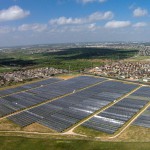[su_divider top=”no” size=”1″]
Note: Household demand satisfied per megawatt (MW)
Many factors influence the number of households whose electricity demand is met by a MW of solar generation. Currently the Solar Energy Industries Association estimates that in the United States the average is 164 households. See the SEIA webpage for a detailed explanation.
[su_divider top=”no” size=”1″]
Texas
State’s installed solar capacity
As of the end of 2016, Texas had a total installed capacity of 1,220 megawatts (MW) of solar energy, according to the Solar Energy Industries Association. This represented a 124% increase over the previous year.
This capacity put Texas in 9th place among the states. The top three states are California, North Carolina, and Arizona.
Data are not yet available on how much of the total capacity is large utility-scale compared to systems installed on commercial and residential properties.
Employment in Texas’ solar industry
The Solar Foundation’s latest National Solar Jobs Census (released in February 2017) found that the number of jobs in the solar energy industry in Texas grew to 9,396 in 2016. This represented an increase of 34 percent over 2015. The 2016 total earned Texas a ranking of third among all the states, a move up the ladder from sixth place in 2015 (although our state is only 37th on a per capita basis).
Number of distributed installations in Texas
Although data on the installed capacity on residential and commercial properties (called distributed generation) is available (see the figure above — 132 MW), data on the number of distributed installations is more difficult to find.
The Texas Solar Energy Society estimates that at least 21,000 residential and commercial properties throughout the state had installed solar energy, usually on rooftops, as of mid-2016.
There is not yet any reliable, standard way of compiling these data. In 2015 the U.S. DOE’s Energy Information Administration began to include a question about distributed installations in its annual survey of utilities, but the EIA admits that reporting is still spotty, although improving.
TXSES’ Larry Howe (a member of the board of directors from Plano) began compiling data in 2015 in order to generate an estimate periodically. The figure above comprises four available components, and is considered a minimum:
| 4,437 | In the territory of San Antonio’s City Public Service (through personal e-mail as of 5/27/16) |
| 5,177 | In the territory of Austin Energy (from March 2016 report) |
| 8,834 | In the deregulated parts of the state (from ERCOT load profile data of 5/16/16) |
| 2,444 | All others (from EIA 2014 annual netmetering report, December 2014) |
| 20,892 | Total (very much a minimum) |
National
Installed capacity of solar generation
Cumulative solar generation capacity for the United States stood at 35.8 gigawatts (GW) at the end of the 3rd quarter of 2016, according to the Solar Energy Industries Association in the latter’s U.S. Solar Market Insight.
With one quarter of 2016 remaining, that already represented a 31 percent increase over the end-of-2015 total (27.4 GW), which in turn had been a 36 percent increase over 2014.
Of this total, 7,260 MW (7.26 GW) had been added in 2015. The latter represented 29.4% of electrical generation from all fuel sources added during the year.
Final data will be available in February or March 2017.
Employment in U.S. solar industry (updated annually)
The Solar Foundation’s National Solar Jobs Census for 2016 found that the U.S. solar industry added about 51,000 workers in 2016. The total number of jobs at the end of the year was 260,077, a 25 percent increase over the previous year.
One of every 50 new jobs in the country in 2016 was in the solar energy industry.
The top five states for total solar employment were California, Massachusetts, Texas, Nevada, and Florida.
One study has concluded that investments in solar energy generate roughly three times as many direct and indirect jobs than comparable investments in fossil fuels.
[su_divider top=”no” size=”1″]
Global
Installed Capacity
According to GTM Research, cumulative installed capacity of PV globally reached 321 GW by the end of 2015. The capacity installed during that year was approximately 59 GW, which represented a 34 percent increase over the capacity installed in 2014.
Efficiencies of Photovoltaic Cells
As of the end of 2016, the efficiency of commercial, silicon PV cells generally ranged from 16 to 20 percent. There is about a 2 percentage point overall drop when the cells are assembled into modules that actually get installed.
Research is ongoing on numerous additional types of cells that are not at this point economic. Some multi-junction concentrator cells have reached about 43 percent efficiency in the lab, with a theoretical efficiency of 80 percent.
U.S. DOE’s National Renewable Energy Laboratory maintains a chart on its website that tracks records of efficiencies reached in the laboratory for various kinds of PV cells.

